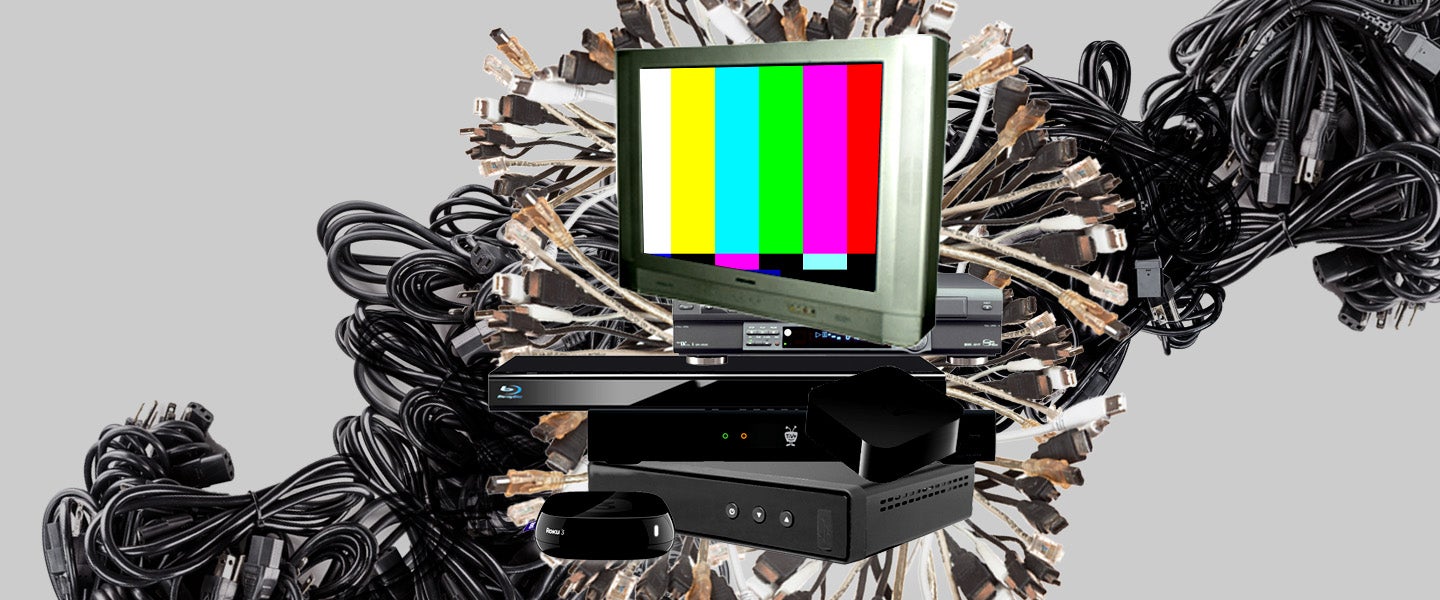For about a decade now, the entertainment business has been urging consumers to abandon the old “big box” model, where we were all forced to shop at one overstocked outlet, containing almost everything we want. They want us all to be boutique shoppers now. When it comes to television in particular, the persistent pitch from the major media companies in recent times has been that if we just subscribe to the right three or four services, not only will we never be bored, but we’ll also never again have to pay a wastefully huge cable or satellite bill.
I know all about the ins and outs of what’s called “cord-cutting” because I wrote a how-to guide for the New York Times a couple of years ago, and spent months researching the best options for anyone eager to unplug their cable, once and for all.
But I have a confession to make: In my own life, I’m in no way a cord-cutter. I’m a cord-clinger — and happily so.
Don’t get me wrong. I still subscribe to a multitude of streaming services. Too many, surely. Personally, though, I’m of the opinion that home entertainment was perfected about 15 years ago, at the moment when high-storage, multi-channel DVRs became a standard part of any cable and satellite package. I love my Blu-Ray player. I enjoy my Netflix subscription. But I’d estimate that about 95 percent of my TV watching is done either live or via TiVo.
And I’m satisfied with that choice. Because the way I see it, cord-clinging offers three distinct advantages over going subscription-streamer-only…
Advantage #1: Old Movies
It’s become a common joke that Netflix doesn’t acknowledge the existence of any movie older than the service itself. That’s an exaggeration, of course; Netflix does feature films made before 1997. But it’s not much of a stretch to say that Netflix doesn’t care about the classics. At present, your best bet if you love vintage cinema — and if you want to get rid of cable — is to subscribe to the Criterion Collection’s new Criterion Channel. Which you should! It’s well-stocked, and magnificently curated.
But frankly, you should keep your cable, too. Leaving aside the remarkable resource that is Turner Classic Movies — an irreplaceable cultural institution, currently unavailable as a standalone subscription service — the multitude of premium and semi-premium movie channels offer plenty of chances to catch up with or revisit the standouts of the recent past. Heck, just the Starz/Encore/MoviePlex package (usually bundled together, since they’re all owned by Lionsgate) could keep a film buff plenty occupied on any given day.
For example, I’m looking right now at the lineup for IndiePlex and RetroPlex. Within the next 24 hours, I could watch Dracula (1931), American Graffiti, The Deer Hunter, Roman Holiday, The Kids Are All Right, Brazil, Dogville and a couple of Westerns I’ve never seen (Red Canyon and The Rare Breed). That’s a pretty good slate of motion pictures — and on just two channels, no less.
I have a routine when it comes to recording movies. Every couple of weeks, I pull up my TiVo’s on-screen programming guide, and go through every HD movie channel I’m paying for, grabbing anything that catches my eye. Is there a film I love that I haven’t seen in a while? Is there something I watched when it came out and have always meant to revisit? Is there something that was popular when I was a kid that I’ve never caught, because it’s not part of the agreed-upon cinematic “canon?” (I watched Flashdance last year for the first time. Not bad!)
I also stay up-to-date on recent theatrical releases this way, just like veteran cable subscribers used to back in the old days of the premium movie channels, when we looked forward to getting the guide in the mail each month, and finding out which big hits from last year were finally coming to the small screen. Whatever I didn’t see in theaters and didn’t watch on Blu-ray, I’ll eventually get around to on HBO and Showtime. Deadpool 2? The latest Halloween sequel? Any given Dwayne Johnson picture? Those are all practically made to be seen months later, on cable.
Advantage #2: Old TV
The streaming services do okay with classic television, but just to a point. If you want to see the juggernauts from the 1970s/1980s heyday of second-run syndication, like Star Trek or The Twilight Zone, oftentimes multiple streamers are licensed to carry them. But if you’re looking to recreate the experience of watching TV Land in the 1990s — when that channel tried to operate like a Turner Classic Movies for vintage TV — then you may find it harder to track down all the shows.
Here’s some good news, though: If you’re a TV Land watcher from way back, the channel MeTV has a lot of the old TV Land vibe, with a good mix of older series (from the mammoth hits to the more obscure), interspersed with fun promos and interviews with venerable stars like Carol Burnett and Alan Alda. A programming service, MeTV is likely carried on one of your local broadcast channels, and thus, is part of whatever local cable or satellite package that’s available to you.
And while MeTV is far and away the class of this category, dozens of similar programming services have proliferated, ever since the government mandated that all new TVs and television broadcasts go digital. As part of that deal, some local channels were granted multiple sub-channels, which have tended to get filled with local news and weather, regional sports or readymade programming from outlets like MeTV, Antenna TV, getTV and Retro Television Network.
If you’re a cable/satellite subscriber, you may have also noticed a cluster of channels with names like Comet, Laff or Grit, which package old TV shows and movies that fit a particular genre. If you’ve always wanted to catch up with Perry Mason or The Life and Legend of Wyatt Earp (one of the first heavily serialized television Westerns), these channels make it easy. And again, a lot of these series aren’t easy to find anywhere other than on regular pay TV.
Also, just like cable helps me stay (relatively) up-to-date with movies I didn’t want to pay to see at theaters, it’s a snap to sample newer TV shows too, when the only effort required on my part is to look at one of the many “What’s On This Week” guides and then set my TiVo. If I read a good review of something that’s airing tonight on NBC, I don’t have to wait until it pops up on Hulu, nor do I have to try to navigate the network’s own app. I can just punch a few buttons on my remote — or on my phone, via the TiVo app — and watch the program as soon as it’s on.
Advantage #3: Channel-Surfing
One of the great joys of human existence that we’ve increasingly lost in the on-demand age is the pleasure of the browse. We used to go into record stores, bookstores and video stores with maybe a few items on our checklist, but also with a willingness to look around. Maybe a well-designed display would attract us. Maybe we’d find something we didn’t know existed, grouped alongside something we already loved. Maybe we’d get sucked in by an eye-catching cover. “Shopping” as a 20th century pastime was less goal-oriented, and more of an exploratory mission into the unknown.
I’m not saying you can’t browse Netflix. Many do! But it’s also true that these days, the algorithms do a lot of our browsing for us. The data shows that people looking at a menu of VOD options don’t generally scroll to the end. That’s why so many of today’s straight-to-video movies begin with the letter “A” (to grab your attention early), and why streaming services keep recommending the same movies to you over and over again (to convince you to watch what they want you to watch).
But for me, as an old man set in my ways, I still get a kick out of interacting with television the way I did when I was a kid — by picking up the remote and wondering, “What’s on?” I work at home, and often, I just want to find something to have on in the background, to keep me company while I catch up on social media, answer emails or get dinner ready. Is there an afternoon baseball game? Is there a good concert on AXS TV? What are they cooking on the Food Network? Is there a Man v. Food marathon on Travel? Is it almost time for Charlie’s Angels on MeTV? Give me a Western… any Western.
One of the big arguments against the cable model is that it forces you to pay for what you don’t want. But how do you really know you don’t want it? Over the past few years, I’ve found shows I really liked on Paramount, OWN, Viceland, History — all channels I likely wouldn’t pick off the menu if I were allowed to select my preferred channels a la carte.
Meanwhile, the great lie of the streaming era has been that we’re not going to need to be tied to a cable, because everything we’ve ever wanted to see is going to be available to us instantly. But in reality, the corporations that control various media catalogs have been increasingly holding back their archives for their own streaming services — which themselves often don’t find it cost-effective to offer the oldies and deep cuts.
Cable isn’t an “everything-on-demand” kind of business either, but it doesn’t pretend to be. There’s something more honest about the bargain cable offers. There’s nothing in the storage room out back. What’s on the shelf is what’s for sale: Each month, the premium movie channels will show the same batch of films a half-dozen times, and HGTV will show the same House Hunters episodes on a loop until the rising oceans claim us all. Nothing more, nothing less.
Honestly, I don’t need much more that that. Even though I’m not giving up my Netflix, Hulu or Amazon subscriptions anytime soon, if I’m being honest, the “we’ll be there when you’re ready” quality of those services makes me feel less urgency when it comes to their content.
If everyone’s buzzing about Russian Doll or The Marvelous Mrs. Maisel, sure, I’ll watch right away, to keep up with the conversation. But I’ll never feel the same sense of satisfaction that I do when I finish a show that’s been piling up on my TiVo and see the percentage of space remaining drop just a bit. The larger world is chaotic, overfull and hard to navigate. But by golly, I know how to manage my TiVo queue.

